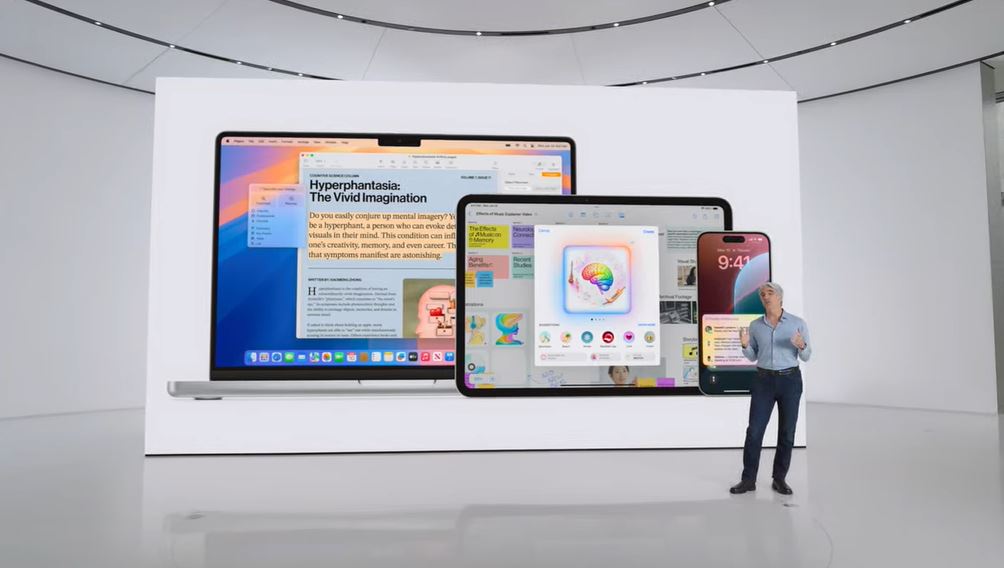Apple Intelligence isn't coming to Intel-based Macs – here's why
There's only so much an Intel CPU can do

As expected, Apple announced Apple Intelligence at WWDC 2024, and it's understandably generating a lot of excitement. But there is one group of Apple users who won't be invited to the new generative AI party: Intel-based Mac owners.
This isn't too surprising, as Apple clearly wants to move everyone over to its newer M-series MacBooks like the M3 MacBook Air and the M3 Max MacBook Pro 14-inch, but there's more to it than that.
That's because as great as they might be, the last generation of Intel-based MacBooks just don't have the hardware necessary to run the kinds of workloads that Apple Intelligence is going to enable, at least not on-device.
The older Intel chips in older MacBooks don't have NPUs
The long and short of it is that Apple Intelligence needs to have what's known as neural processing unit, or NPU, to do any kind of AI workloads on device. Things like text and image generation require more than just the CPU in order to work efficiently, and even the most basic AI workloads would pretty much slow an older Intel-based MacBook to a crawl, if not outright freeze it on you.
Intel's 10th-gen processors in the early-2020 MacBook Pro and MacBook Air models are not bad processors, to be clear; they're actually some of the best processors you could get in a laptop up until just a year or two ago, so even though they're older, they still very good for most people's needs.
But those processors don't have an NPU, so if you tried to run an AI workload on them they would have to use the main processor, which lacks the specialized hardware needed to create and run the neural network that pretty much any AI application requires. Could a CPU run a neural network? Yes, but the processing time would be so long that you would be better off using cloud-based tools like ChatGPT or Midjourney.
In fact, it's entirely likely that Apple Intelligence wouldnt even let you run it on an Intel-based Mac, if you tried.
Sign up for breaking news, reviews, opinion, top tech deals, and more.
What to do if you want to get in on Apple Intelligence?

Sadly, if you love your Intel-based Mac or MacBook but you want to get in on some of the AI stuff that's hitting the scene this year, you'll have to buy a new Mac or MacBook with at least an Apple M1 chip, which is the first Mac product to feature a 'neural engine', which is Apple's name for its NPU.
Many of the best laptops coming to market this year have NPUs as well, so Windows laptops will also have advances AI features. If you want to stick with the best MacBooks and Macs, however, you're probably going to need at least an Apple M3 chip to use Apple Intelligence effectively.
It has much more processing power than the M1 (the Apple M3 gets through about 18 trillion operations a second, or TOPS, compared to the 11 TOPS in the Apple M1). And considering that the Apple M4 features 38 TOPS, you're probably better off waiting for new MacBooks to launch with the Apple M4 chip later this year.
You might also like...
- iOS 18 finally brings in a gaming upgrade for iPhones that Android phones have had for years
- macOS 15 Sequoia: launch date, latest news, rumors, and everything we know
- iOS 18 confirmed: major upgrades are coming to Mail, Messages, Photos and more

John (He/Him) is the Components Editor here at TechRadar and he is also a programmer, gamer, activist, and Brooklyn College alum currently living in Brooklyn, NY.
Named by the CTA as a CES 2020 Media Trailblazer for his science and technology reporting, John specializes in all areas of computer science, including industry news, hardware reviews, PC gaming, as well as general science writing and the social impact of the tech industry.
You can find him online on Bluesky @johnloeffler.bsky.social